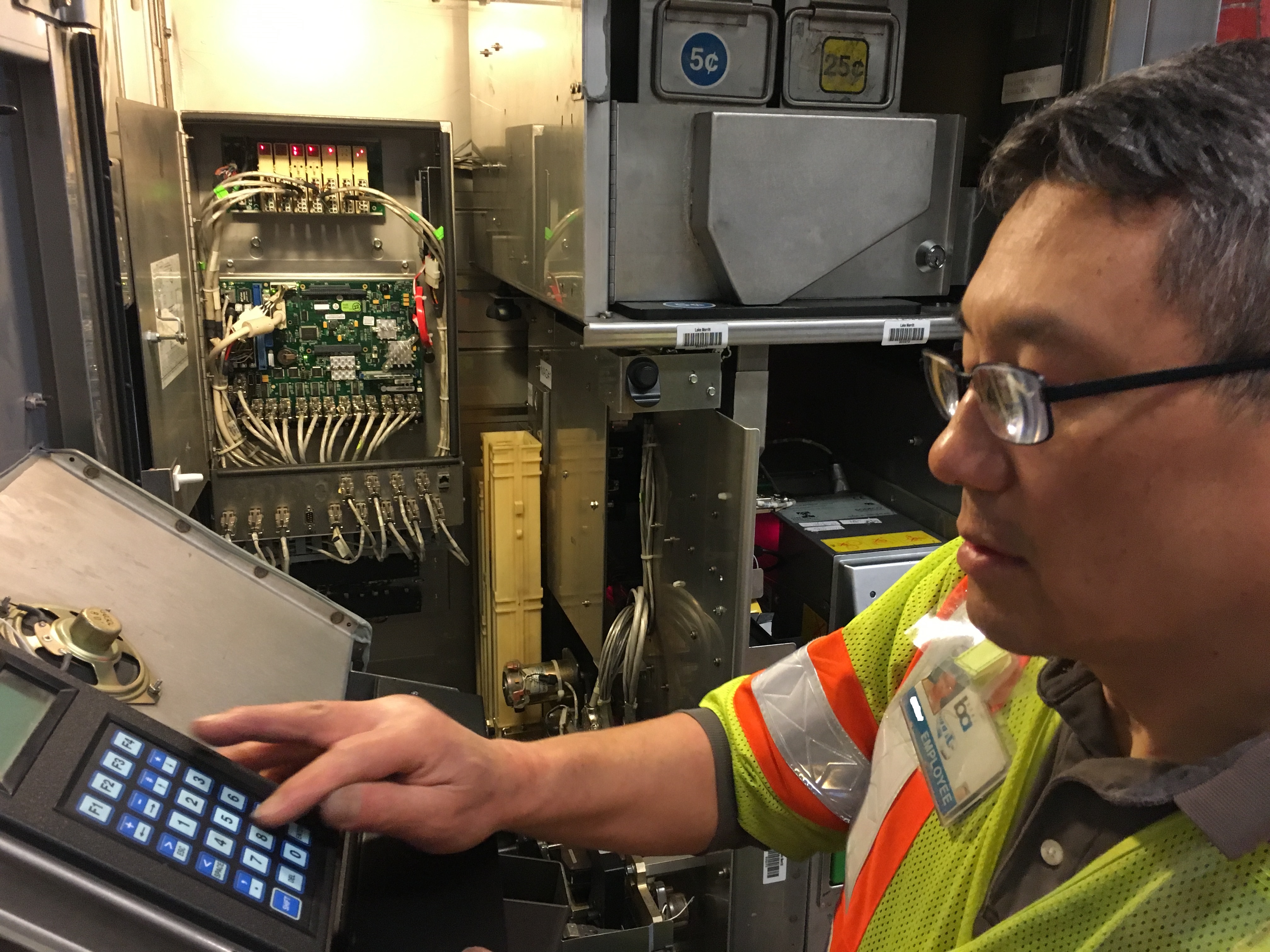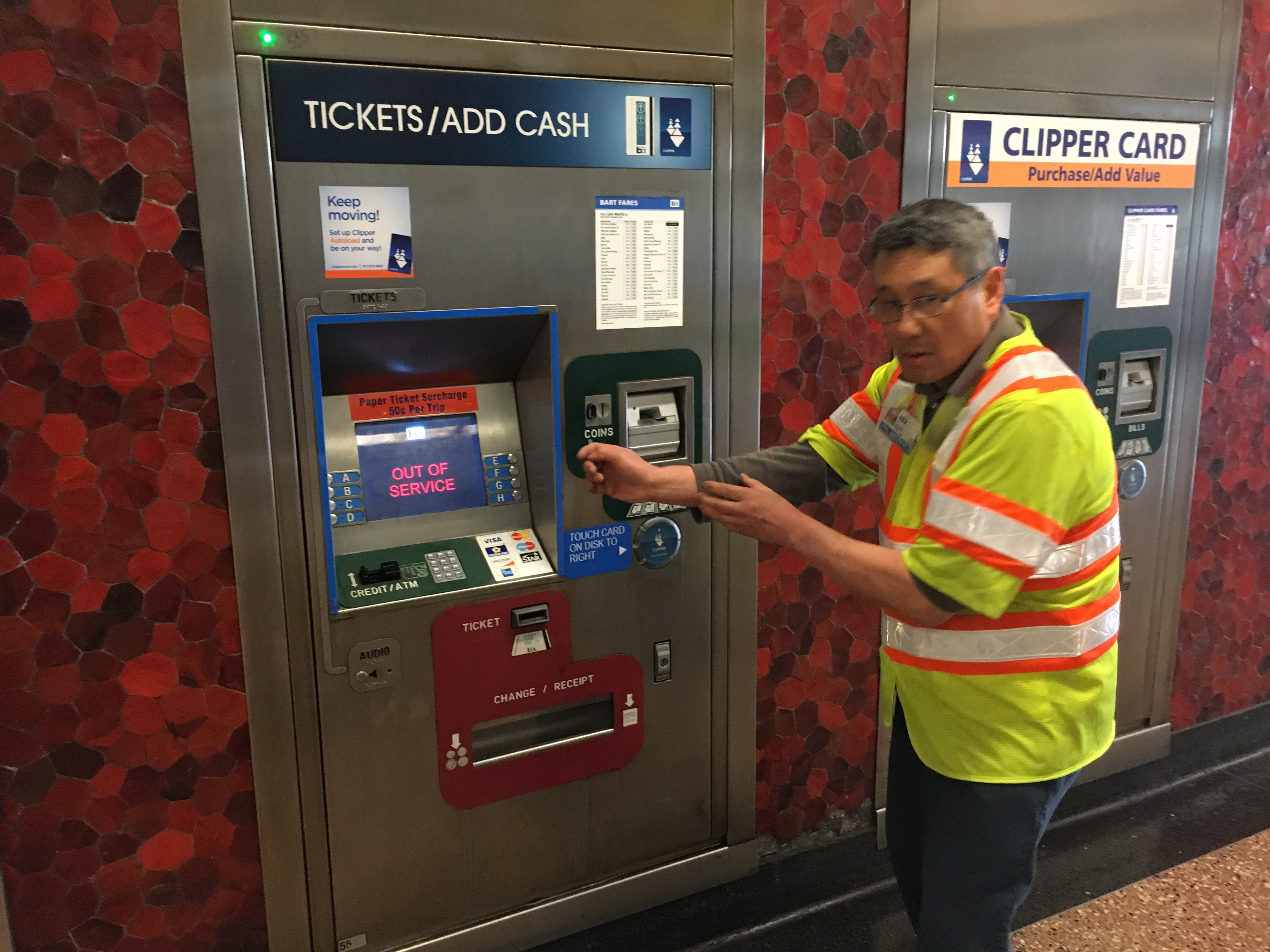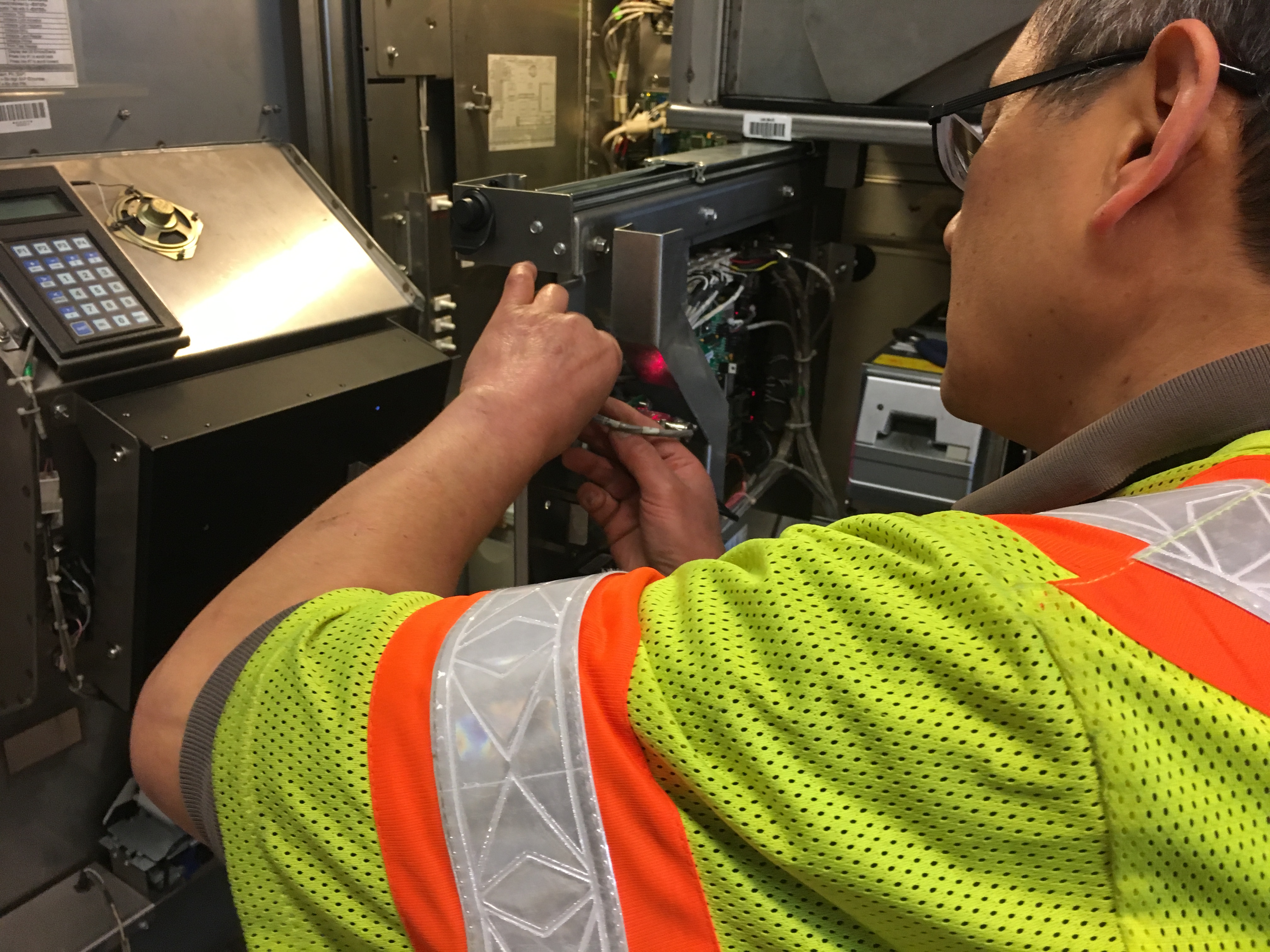There's more to Ticket Vending Machines and fare gates than meets the eye
There’s a lot of technology that goes into making sure you can easily reload your Clipper card or buy a BART ticket and get quickly through the fare gates.
On this latest edition of “Hidden Tracks: Stories from BART” we’ll take an inside look at what makes BART’s Ticket Vending Machines and fare gates tick. It takes a dedicated team to keep an array of roughly 1,200 machines in good working order. One of the biggest challenges is dealing with paper tickets, both authentic and counterfeit, that can jam up busy machines
First, we’ll visit with one of the technicians who is specially-trained to get malfunctioning machines back in action.
Then we’ll hear from John Yen who manages the team that oversees vending and fare gate machines. He’ll share more about the technology upgrades the Ticket Vending Machines have gone through and what BART is doing to make sure they stay in operation for years to come.

Transcript below:
HOST: “The sound of a properly working Add Fare Machine is music to the ears of Ed.”
ED: “I did an overall check to make sure everything is ok, generating tickets. Then I close it up.”
HOST: “Ed is one of the highly trained technicians who responds to problems ranging from malfunctioning coin slots to challenging paper ticket jams.“
ED: “The main thing that I see with tickets is that people don’t take care of them, they get a little managed and then they jam in the machines. We’ve experienced a lot of times with these scammers, oh my goodness, they get these tickets with glue and stuff like that and that creates a lot of problems. So, all our rollers and stuff are full of glue and their sensors and stuff get all dirty. It’s kind of like vandalism caused by these scammers.”
HOST: “It’s a common problem that could become less so with BART’s aggressive push to encourage riders to use Clipper. Ed says most paper jams can be solved quickly…but it only takes a few tough cases to have a big impact.”
ED: “Most people are careful but there’s maybe 10 percent of the time, but that 10 percent sometimes is really bad.”
HOST: “You take out a gate, you take out one of our TVM machines it causes a line and people really notice that sort of thing.”
ED: “Yes, they do. There are people they still want to buy paper tickets and when one machine goes out it’s because someone had a bad ticket and it’s something that the agent can’t clear. That really causes a lot of problems.”
HOST: “Ed’s seen it all when it comes to these machines. He’s been doing repairs for BART since 2001. His beat is a handful of East Bay stations.”
ED: “I was just at Fruitvale. I serviced one vendor, one add fare, two gates and that was just while I was at Fruitvale. When I go visit a station it’s not unusual for me to service at least one or two machines. Miscellaneous mainly coins and bills. They get jammed, especially rainy days when people have wet bills, ooooh, when people put wet bills in there it jams all the time.”
HOST: “Ed is dedicated to his job and it comes through. He knows his machines inside and out.”
ED: “It makes everybody’s job easier. I treat them like they’re my own children, if you take care of them they’ll take care of you. That’s a big deal because every little thing you can avoid that’s more time that you have. It’s like an old saying that a stitch in time saves nine or something like that so if you can find a minor problem, if you don’t take care of it, it becomes major.”
HOST: “The efforts of Ed and his fellow technicians are a big reason why BART kept 99.6 percent of its fare gates and nearly 96 percent of its Ticket Vending Machines in service during the latest quarter.
Now let’s meet John Yen. He’s the Manager of Fare Collection Engineering and is the leader of the team dedicated to keeping the fare gates and Ticket Vending Machines running.”
HOST: “John Yen joining me now, thank you so much for taking some time to speak with us.”
YEN: “Absolutely, thank you very much for the opportunity.”
HOST: “Now you lead a team that’s essentially the brains behind our fare gates and Ticket Vending Machines. Those machines of course are a critical part of the BART system and the fact is they’re more complicated than they may look on the surface, isn’t that right?”
YEN: “Absolutely. What we’re talking about here is we have computers inside this equipment that are talking to a lot of different peripherals and just imagine all the individual components: the bill exchangers, the ticket machines, the coin and bill handling, Clipper card. There’s a lot of complex integration between hardware and software in each piece of equipment.”
HOST: “Pretty recently we completed something called an asset refresh on the Ticket Vending Machines. What is that and what did it accomplish?”
YEN: “The current set of Cubic equipment, Cubic is the manufacturer of the equipment, they were initially installed back in 2002 so we were anticipating the equipment to have a lifetime of about 15 to 20 years. What we did between 2016 and 2017 is we did a midlife refresh. We kept the stainless-steel boxes outside and we replaced many of the electronic components, all the computers, all the electronic components. A lot of them were obsolete and a lot of them are no longer serviceable so we have to keep the equipment operational hopefully for another 10 to 15 years so we ripped out a lot of the electronic components and replaced them up to date technology.”
HOST: “This is a way in essence for BART to get more life out of these machines without having to buy whole new machines.”
YEN: “Absolutely, we’re talking about comparing tens of millions in refresh work versus spending hundreds of millions of dollars in replacing the entire system and entire boxes.”
HOST: “How are reliable are these machines, in general?”
YEN: “In general they’ve very reliable. Usually we have up time of 95-98% uptime for all the equipment. Typically, we’re shooting for fare gates at 99% uptime. They’re very reliable, there’s a lot of work that’s being done to keep them up and running. We have a great team of maintenance technicians out there just to keep them running.”
HOST: “And you mentioned 99% in terms of efficiency, that’s a really high target and there are about 1,200 machines all throughout the system that you manage. It sounds like a lot.”
YEN: “It is a lot. Just imagine we have a lot of computers out there and every one of them is going to be doing something a little bit different. They’re all configured differently, they do slightly different things depending on where they are and what they do. It’s a big task to manage the configuration and make sure that they’re all operating correctly.”
HOST: “Now the work that’s been done has really been on the guts of these machines, the inside that customer never see. Has there been any considering to make any changes to the user interface?”
YEN: “There are certainly some considerations for making changes to the user interface. The first thing that we should see in the next two to three years is we’ll start accepting chip credit cards, the EMV cards. What that means is we’re going to be seeing some new devices installed on the front of the Ticket Vending Machines. We’re probably also going to be looking more towards accepting mobile payment at some point on the Ticket Vending Machines. There’s always a consideration going forward in looking at the wearables, the mobile payment, and the cellphones. There are a lot of things under consideration so we are proceeding very carefully, very judiciously to make sure that we are doing the right thing, making sure that we’re providing the best experience for our customers.”
HOST: “I’m speaking with John Yen who is the manager of fare collection engineering here at BART and we’re talking about the Ticket Vending Machines and add fare machines in our system. 99% availability is a great goal and is something that stands out and is important for our riders. One of the big changes happening right now at BART is a big push to get more folks to use Clipper. Obviously, that’s a big deal when it comes to our fare gates and how they function. Talk about that, what kind of an impact could that have in terms of more people using Clipper as opposed to paper tickets?”
YEN: “With paper tickets it is a 40-year-old technology and it does require a lot of mechanical equipment to move the tickets around within the fare collection equipment. The maintenance of those transports is relatively troublesome. We know how to do the business, we know how to repair them, we know how to fix them but ultimately at some point in the near future hopefully we won’t have any ticket acceptance, we’ll have a very simple device that simply does nothing but accept Clipper and the customer simply has to tag the target. There are no moving parts, maintenance should be a lot simpler, and we’re getting there. Right now, with the fare increase and the surcharge were seeing a big change in the way customers are using Clipper cards versus tickets and we’re hoping that trend continues.”
HOST: “Looking at it as we move towards Clipper it sounds like that’s a way that could not only make it easier for customers in terms of getting through the fare gates more quickly, it sounds like it would keep even more of our machines in service.”
YEN: “I would hope so. It’s really going to reduce the maintenance requirements and perhaps within a few years we’re going to start talking about purchasing the next generation of fare collection equipment. We’re fully intending on not supporting magnetic tickets going forward with the new generation but we just need to look at how do we get there.”
HOST: “One of the things I’ll hear from customers time to time as we talk about the BART system is a lot of them they obviously don’t like fare evasion and they’ll say, ‘well the BART fare gates, they should be taller or they should be redesigned’ or something like that. I would imagine something like that, a change like that is easier said than done.”
YEN: “It is a lot easier said than done. What we’re talking about is we’re bringing in a new set of equipment, there’s going to be a lot of functionality that we need to make sure they work within the BART operating parameters. There’s system integration, we want to make sure that we are able to monitor them, we’re able to get data from them. From a system integration perspective this is not going to be an easy task.”
HOST: “And I would imagine it would be a pretty significant cost as well.”
YEN: “Absolutely, absolutely.”
HOST: “One thing that’s interesting too is in terms of how the fare gates function they actually open in an emergency, if I understand correctly. How does that work?”
YEN: “Correct. The fare gates are tied to the station fire alarm panel so if there’s an emergency, somebody pulls an alarm they would trigger the fare gates to open so everybody can exit the system safely.”
HOST: “These fare gates get a lot of use. We have more than 400,000 customers on a typical customer and they’re all going through the fare gates one way or the other. How are they holding up overall with such heavy use in our system?”
YEN: “I think they’re holding up great. Like I said we have a great team of technicians out there taking care of any problems but for the most part, 99% up time on the fare gates and they’re working very nicely.”
HOST: “I had the opportunity to go out with one of the technicians and it was really neat to see because they’re learned the system so well, they’re responsible for individual stations so they really know the machines at their stations and they have that individual ownership of keeping those machines running. It was really a neat thing to see.”
YEN: “They take pride in doing the work. They’re responsible for making sure that the equipment is functioning properly so if there are any issues they know bring them back on line and they know how to take care of the problems.”
HOST: “Technology changes so quickly and you mentioned these machines had already been in the system about 15, 20 years and we did that asset refresh. Does that present any challenges? The asset refresh should bring some updates into play but is any of the technology still kind of dated, is it still kind of old and maybe more difficult to work with?”
YEN: “Just imagine that you have a computer, a personal computer at home and you probably have to replace it every three or five years at most. Well, we’re talking about a computer here that’s a lot more customized, a lot more integrated so we’re not going to replace the equipment as quickly. But every time that we do run into a problem with it becoming obsolete we do need to make sure that we replace not just the computer but make sure all the peripherals are working, the software is working, just need to keep it running. We’re hearing from a Board level perspective, from a lot of public interests there are always ideas for how we can improve the system. We just have to weigh each one carefully, weigh the cost benefit and see whether it’s a really good idea or something we could do easily and will have a long-term return on investment and we also want to make sure that they’re maintainable so we don’t put something out there that gets broken easily or is hard to repair. Those are all the considerations we have to consider.”
HOST: “John, thank you so much for your time with this.”
YEN: “Thank you very much.”
HOST: “That’s John Yen, he’s the manager of fare collection engineering here at BART. And thank you for listening to ‘Hidden Tracks: Stories from BART.’ You can listen to our podcasts on SoundCloud, iTunes, Google Play, Stitcher, and of course at our website BART.gov/podcasts.”

